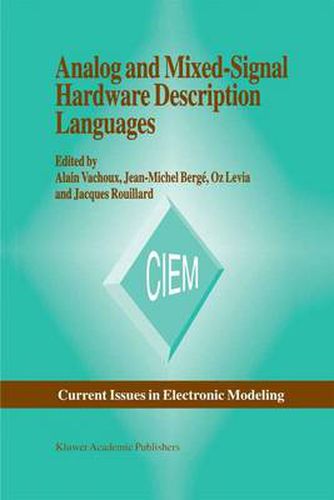Readings Newsletter
Become a Readings Member to make your shopping experience even easier.
Sign in or sign up for free!
You’re not far away from qualifying for FREE standard shipping within Australia
You’ve qualified for FREE standard shipping within Australia
The cart is loading…






This title is printed to order. This book may have been self-published. If so, we cannot guarantee the quality of the content. In the main most books will have gone through the editing process however some may not. We therefore suggest that you be aware of this before ordering this book. If in doubt check either the author or publisher’s details as we are unable to accept any returns unless they are faulty. Please contact us if you have any questions.
Hardware description languages (HDL), such as VHDL and Verilog have found their way into almost every aspect of the design of digital hardware systems. Since their inception they have become an essential part of modern design methodologies and design automation tools, exceeding their original goals of being description and simulation languages. Automatic synthesis, formal proof, and testing are examples of their many uses. So far, HDLs have been mainly dealing with digital systems. However, modern integrated systems require more and more analog parts such as A/D and D/A converters, phase locked loops, and current mirrors. The verification of the complete system, therefore, requires the use of a single language. Using VHDL or Verilog to handle analog descriptions is possible, as shown in this book, but the real power comes from true mixed-signal HDLs that integrate discrete and continuous semantics into a unified framework. Analog HDLs (AHDL) are considered here a subset of mixed-signal HDLs as they intend to provide the same level of features as HDLs, but with a scope limited to analog systems, possibly with limited support of discrete semantics. Analog and mixed-signal HDLs cover several aspects related to analog and mixed-signal hardware description languages including: the use of a digital HDL for the description and the simulation of analog systems; the emergence of extensions of existing standard HDLs which provide true analog and mixed-signal HDLs; the use of analog and mixed-signal HDLs for the development of behavioural models of analog (electronic) building blocks (operational amplifier, PLL) and for the design of microsystems which do not only use a front-end tool which eases the description task with the help of a graphical paradigm, but generate AHDL descriptions automatically. This book shows how to use these hardware description languages in the design of electronic components and systems. It should be useful reading for researchers and designers working in electronic design.
$9.00 standard shipping within Australia
FREE standard shipping within Australia for orders over $100.00
Express & International shipping calculated at checkout
This title is printed to order. This book may have been self-published. If so, we cannot guarantee the quality of the content. In the main most books will have gone through the editing process however some may not. We therefore suggest that you be aware of this before ordering this book. If in doubt check either the author or publisher’s details as we are unable to accept any returns unless they are faulty. Please contact us if you have any questions.
Hardware description languages (HDL), such as VHDL and Verilog have found their way into almost every aspect of the design of digital hardware systems. Since their inception they have become an essential part of modern design methodologies and design automation tools, exceeding their original goals of being description and simulation languages. Automatic synthesis, formal proof, and testing are examples of their many uses. So far, HDLs have been mainly dealing with digital systems. However, modern integrated systems require more and more analog parts such as A/D and D/A converters, phase locked loops, and current mirrors. The verification of the complete system, therefore, requires the use of a single language. Using VHDL or Verilog to handle analog descriptions is possible, as shown in this book, but the real power comes from true mixed-signal HDLs that integrate discrete and continuous semantics into a unified framework. Analog HDLs (AHDL) are considered here a subset of mixed-signal HDLs as they intend to provide the same level of features as HDLs, but with a scope limited to analog systems, possibly with limited support of discrete semantics. Analog and mixed-signal HDLs cover several aspects related to analog and mixed-signal hardware description languages including: the use of a digital HDL for the description and the simulation of analog systems; the emergence of extensions of existing standard HDLs which provide true analog and mixed-signal HDLs; the use of analog and mixed-signal HDLs for the development of behavioural models of analog (electronic) building blocks (operational amplifier, PLL) and for the design of microsystems which do not only use a front-end tool which eases the description task with the help of a graphical paradigm, but generate AHDL descriptions automatically. This book shows how to use these hardware description languages in the design of electronic components and systems. It should be useful reading for researchers and designers working in electronic design.